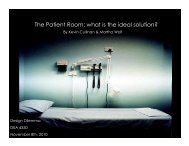The role of physical design and informal communication
The role of physical design and informal communication
The role of physical design and informal communication
Create successful ePaper yourself
Turn your PDF publications into a flip-book with our unique Google optimized e-Paper software.
However, when asked if all <strong>of</strong> this socializing impacts the ability to focus on the<br />
tremendously important responsibility <strong>of</strong> dispensing meds, the interviewees did report<br />
that it is sometimes a problem:<br />
“That’s the pros <strong>and</strong> cons <strong>of</strong> being in that med room, is that, you<br />
have that space but at the same time if you’re not in the interaction,<br />
it’s frustrating because you can’t concentrate.”<br />
Interviews also revealed that the kitchen (for preparing/accessing patient snacks <strong>and</strong><br />
drinks) is a space commonly used for social interaction for the same reason – it is an<br />
enclosed space where staff cannot be seen or heard by patients <strong>and</strong> visitors.<br />
Unfortunately the kitchen is one <strong>of</strong> the “backstage” areas where the researcher did not<br />
follow the GN, so this information was not captured by the CWM tool. A final note<br />
about the med room is that while it is a hub for social interaction, it is also where the<br />
GN did one third <strong>of</strong> her non-interactive tasks. Observation revealed that the GN <strong>of</strong>ten<br />
did not participate in the socializing that was occurring, but rather kept her head down<br />
<strong>and</strong> her back to the others as a signal that she was concentrating.<br />
Table 9 shows that little interaction occurred at the charge nurse desk.<br />
However, this is an inaccurate representation because, as explained previously, the<br />
relocation <strong>of</strong> the charge nurse from Desk B2 to B1 resulted in unreliable data<br />
collection when it came to recording the actual location <strong>of</strong> the charge nurse desk.<br />
Fortunately, field notes revealed that there was actually a fair amount <strong>of</strong> interaction<br />
that occurred around the charge nurse. Because the charge nurse always has in front<br />
<strong>of</strong> her a pile <strong>of</strong> patient charts that she is updating <strong>and</strong> because she has information<br />
about the status <strong>of</strong> all patients, including doctors’ orders, test results, etc, nurses <strong>of</strong>ten<br />
hover around the charge nurse desk because it’s the primary source <strong>of</strong> information.<br />
While not reflected in the CWM tool data, “Seeking Advice,” “Being Taught,” <strong>and</strong><br />
“Validation” <strong>of</strong>ten occurred at the charge nurse desk. Importantly, these activities<br />
84







